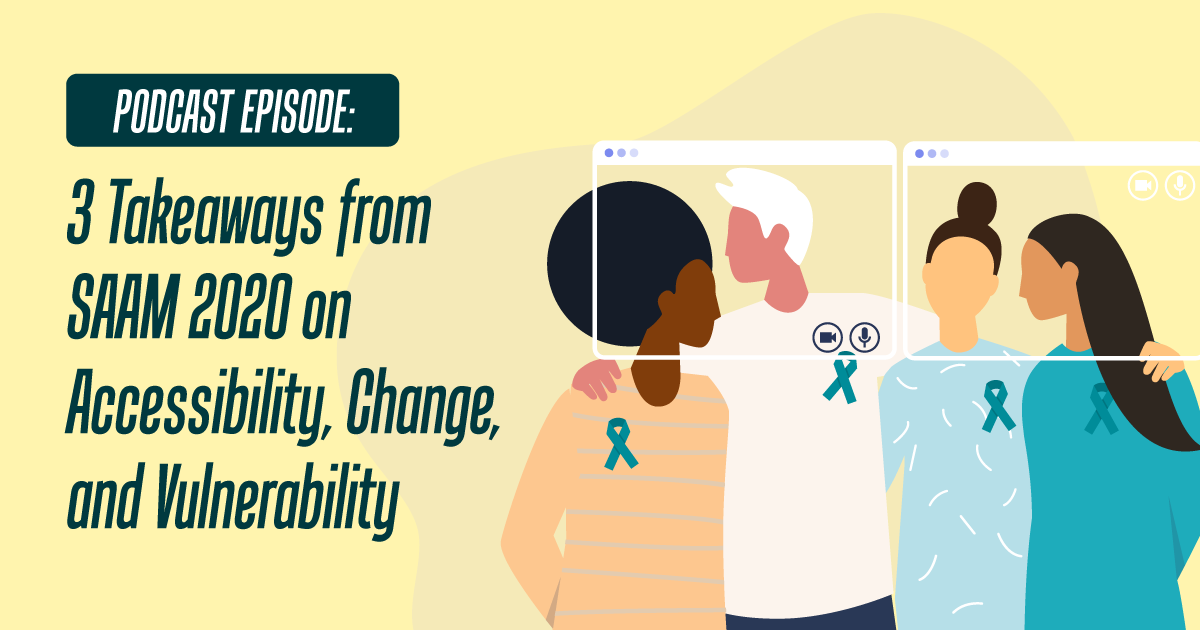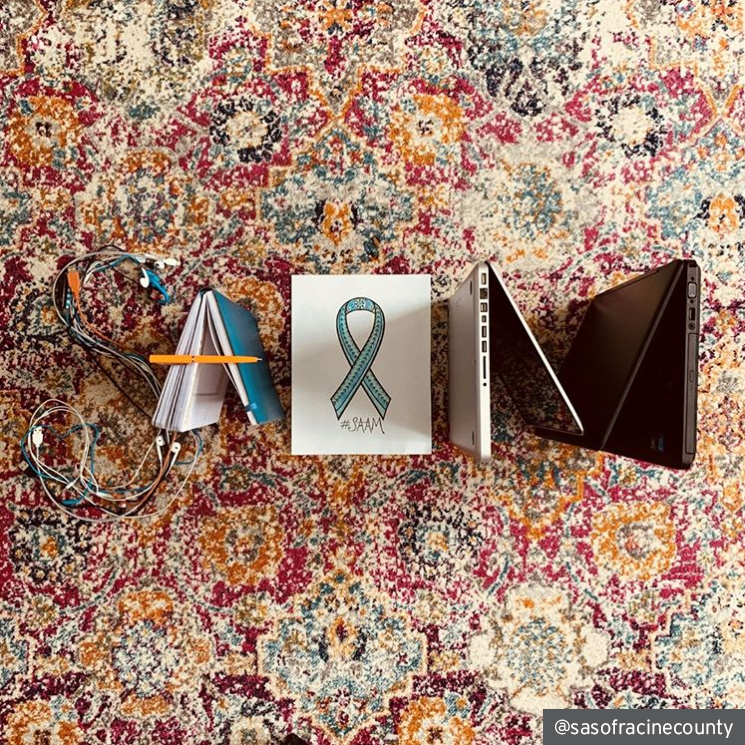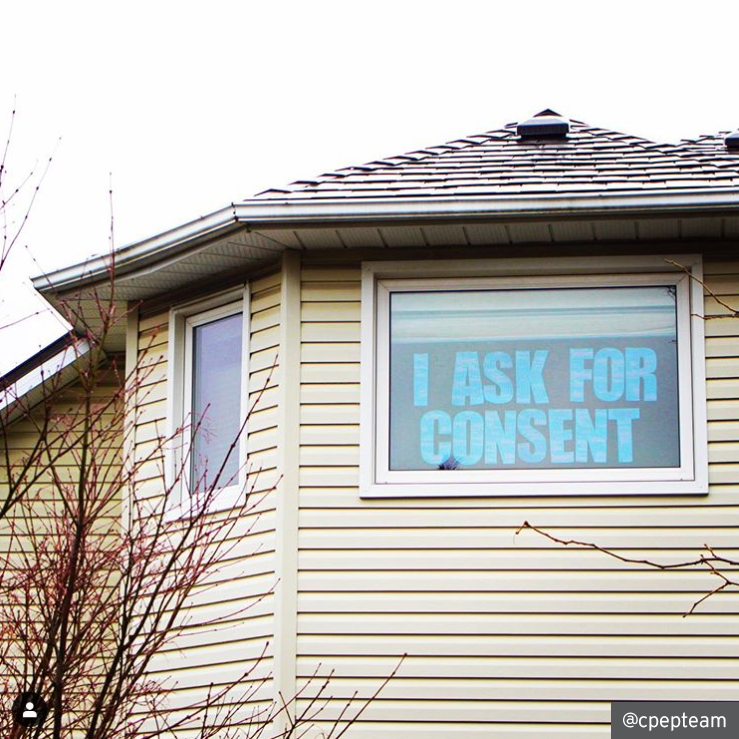
On this episode of Resource on the Go, we discuss how this year's Sexual Assault Awareness Month drastically changed due to COVID-19 and the broader takeaways we can all continue to apply to our prevention and outreach work. Topics covered: why all our work should be accessible, Black Lives Matter and its connection with sexual violence prevention, the importance of vulnerability in our work, and continuing the momentum of change in outreach strategies going forward.
Takeaways from the First-Ever Completely Virtual Sexual Assault Awareness Month
This year, for the first time in its nearly twenty-year history, Sexual Assault Awareness Month was observed solely in online spaces this past April. This alone would mark a significant moment in the campaign’s history, but an added layer was the unforeseeable circumstances under which it came about.
For nearly two decades, April has marked Sexual Assault Awareness Month or SAAM — a time when sexual assault advocates, survivors, and allies throughout the country spread awareness about sexual assault and share educational messages on how to prevent it. This year, just days ahead of April, SAAM events that had been months in the making — survivor solidarity nights, fundraising events for local programs, consent and healthy sexuality workshops, and more — were canceled or indefinitely postponed in the wake of COVID-19.
Over the years, SAAM events have been planned at the local level by organizations and programs like community and campus rape crisis centers. While SAAM is commemorated through different types of events across campuses and communities, all events have similar aims of showing public support for survivors, spreading awareness about community resources for them and their loved ones, offering healing spaces for survivors, and sharing important messages about healthy communication, sexuality, and consent, which help prevent sexual assault, harassment, and abuse.
This year, at a time when state stay-at-home orders were falling into place and little felt certain, there seemed to be a unanimous and unspoken agreement from sexual assault advocates across the country that SAAM must go on. With a small window of turnaround time and working from home offices or dining room tables, advocates found new ways to take their SAAM outreach online. This meant that staple community events — which in many cases have been refined over the years — were replaced with online actions that were being experimented with during the most visible and important time of the year for the anti-sexual violence field.
Thanks to the work of advocates nationwide, SAAM was observed for the first time in its history almost completely in online spaces. For example, Stanford University, which has had in-person SAAM events for the last five years, held its first-ever virtual campaign which took popular events — like Take Back the Night and Denim Day — online. There was no playbook on how to make any of these virtual events happen, but rather the urgent and compelling need to innovate that helped these events make the jump to virtual spaces. This transition brought with it growing pains — but also imparted valuable lessons that sexual assault advocates, and others planning public health campaigns, can carry forward into this new normal.
Knowing Your Value Can Determine Focus and Direction
During the second week of April, the National Sexual Violence Resource Center, or NSVRC, facilitated an ad hoc webinar intended to unify advocates and generate discussion on virtual event ideas and implementation. At this point, all in-person events had been canceled — meaning weeks, if not months, worth of planning for those events that wouldn’t come to fruition. Some organizations even shared with us their big plans for the month that had been deferred.
With little turnaround time and other logistical issues, like the unexpected and sudden shift to working remotely, it was clear that — even with a virtual event — there might not be the latitude to accomplish every previously established goal.
The advice NSVRC gave to advocates at that time was the same advice that we were using to guide our online organizing efforts: Identify how your organizational voice is most valuable at this moment and build your strategy around that. This guidance was intended to help organizations focus on the best way to make use of their efforts and time. For some organizations, that may have meant giving space for survivors to share their stories on a Zoom call; for others, that might look like sharing timely messages on digital consent and boundaries. Not only did this help to ensure that the events were worth the time of the advocates planning them, but it also ensured that they were valuable to community members who participated in them.
The value of an organizational voice can shift from cultural moment to cultural moment — especially with a topic as broad and intersectional as preventing sexual violence. The COVID-19 pandemic was unprecedented in the ways that it so universally impacted our day-to-day lives. However, taking frequent temperature checks on the value organizations can bring to communities is always important — as is making sure outreach efforts reflect and match that need.
It’s Okay — and Important — to Show We’re Human Too
Due to stay-at-home orders in most of the country this April, much of the work behind SAAM was carried forward from dining room tables, living rooms, and home offices. Not to mention, with school and daycare closures, parents were filling the role of caretaker and teacher in addition to their work responsibilities during the workday. Nowhere was this shift more evident than in the #30DaysofSAAM Instagram Challenge, a month-long contest that prompts participants to share photos daily.
The goal of the #30DaysofSAAM — which has been a part of NSVRC’s SAAM campaign for the past seven years — is to keep the conversation about supporting survivors and preventing sexual assault going throughout the month in a creative space. Typically, the challenge is full of photos taken at events. This year, the submissions looked a little different, with many of the shots reflecting home workspaces, pets, children, and other sights from around the house. This didn’t make those posts any less impactful or educational as participants made the most of the situation to share timely anecdotes on boundaries and consent.
For example, April 16’s prompt was: “An Activist’s Desk — share a snapshot of some of the SAAM supplies, resources, or symbols in your world.” Take a look at how this campus sexual assault advocate shared a photo of their workspace alongwith the following caption:
“An Activist’s Desk⠀
These days I find myself sharing my desk space with my partner who is also working from home and teaching pre-k remotely. There have certainly been some days where my background music has been hearing about the life cycles of a plant!⠀
Sharing space with someone requires active communication, boundary setting, and conversations about consent. No matter how well you may know the person or people, new situations require new discussions. You may need to talk about when you need alone time or how much personal space is comfortable for you but is also possible within the confines of your space. Do you consent to the people in your space sharing information about you in meetings or social media (I asked my partner if I could share about his teaching). How do you communicate with the people in your space if you suddenly find yourself sharing space with them 24/7 or you have moved back home after a time of independence? ⠀
Boundaries and consent are necessary in so many situations and are active skills that we continue to work on throughout our lives.”⠀
Another example from the #30DaysofSAAM spotlights the reality of doing this work at this moment.

“#Day13 showcases my work from home #SAAM essentials: headphones, planner, teal ribbon for my front window, and laptop(s). We won’t let “Safer at Home” stop SAAM in our community! Not pictured: my partner working right next to me, my kids asking for snacks every two seconds, and ten cups of coffee per day.”
With an issue as prevalent as sexual assault, it can be too easy to only see statistics instead of individual lives impacted by this violence. The #MeToo movement, founded by Tarana Burke, showed everyone the impact that individual personal stories can have in shifting public thinking about this issue. Perhaps now is an appropriate time to put a human face on the advocates — and not just the organizations — doing this work as well.
New Approaches Can Help to Meet People Where They Are
This moment compelled organizations to identify new ways to reach their communities or face the reality of reaching no one at all. The truth is that in-person events may not be reaching everyone even in the most “normal” of times.
Prior to now, there were still barriers that kept folks from attending in-person SAAM events. For instance, on college and university campuses — commuters, part-time students, online learners, students with jobs on or off-campus, or students who are parents — may not have the availability to attend campus events that take place outside of their class schedules. Beyond that, there may also be folks who, for various reasons, might not have felt comfortable attending an in-person event, but would feel comfortable participating from behind a screen.
Closing the gap by meeting community members where they are extends beyond online spaces as well. This April, some local programs found ways to share messages from the I Ask for Consent campaign by placing visuals in locations that could be viewed from a safe distance.

Moving forward, that same adaptive mindset can help to restructure the ways we think about meeting people where they are. For instance, if folks are holding meetings on Zoom, encourage them to use a teal ribbon background. If you’re trying to reach Gen Z, it might be time to think about incorporating platforms like Tik Tok into your outreach. If folks cannot come into an organization’s physical space, how can you reach them from the street? Shaking up outreach strategies can help organizations connect with individuals they may not have been reaching before and find new ways to let community members engage with their work.
Growing Your Online Presence and Finding Effective Ways to Message Prevention Through Social Media is a Necessity
It should go without saying that now is a time for organizations to grow their online presence and re-engage existing audiences. In this sort of digital renaissance, where so much has shifted online, it’s important for organizations to progress with the times so their messages reach those who need to hear it. NSVRC, for example, has expanded our online outreach to include a Giphy page to help make sharing messages about consent more accessible.
To help organizations get started, National Network to End Domestic Violence has created a Digital Services Toolkit for advocates that can help them think through implementing tech-based tools — including a guide on how to prevent “Zoom-Bombing.” Or, if an organization already has an active social media following, look for gaps. Are there specific age groups that you aren’t reaching on Facebook? Look into what social media platforms the age group you are most trying to reach is on. If you’re not sure, try asking youth leaders in your community for advice. (If you don’t have youth involved with your program development, you might want to take some time to assess their readiness.)
For broader support in reassessing how to message sexual assault prevention, NSVRC and Berkeley Media Studies Group have a guide that can help. Moving Toward Prevention: A guide for reframing sexual violence can help organizations effectively talk about sexual assault prevention — both in-person and online — to the general public. Organizations can better understand how to develop messages that will resonate with different audiences and in many contexts.
It’s important to not just grow and assess an organization’s online presence during SAAM or during a pandemic, but regularly. By looking for new ways to build and tailor your engagement and prevention messaging, whether that’s through social media, email newsletters, or a new platform, you can help ensure your message comes through in these changing times.
Come What May — We Will Carry the Light of SAAM Forward
For nearly two decades, sexual assault advocates turned their community spaces teal with SAAM events. Prior to that, before SAAM’s official establishment in 2001, predecessors in the movement to end sexual violence paved the way to bring us here with nearly thirty years of advocacy and progress.
April 2020 — a month that will likely become synonymous with COVID-19 and social distancing — could have been the time when the light of SAAM finally dimmed. But sexual assault advocates persevered, refusing to let the visible support for survivors that the month brings waver on their watch. Online events continued to be added to NSVRC’s event list right up through the end of the month, critical conversations around digital consent and boundaries became more prevalent, and #SAAM was just as active as ever.
This past April was a moment that compelled organizations to shake up and innovate outreach because it was clear to see what was at stake otherwise. Let’s keep that same energy with us moving forward as we think about new ways to take our advocacy online, because there is always a lot at stake if we can’t get messages about consent, boundaries, and healthy relationships across — it’s just not always as apparent. In this “new normal” we’re heading into, we must keep reflecting, innovating, and adapting to the best way to support survivors and prevent sexual assault, harassment, and abuse.
List of Virtual SAAM Events/Activities:
Awareness Raising/General
#30DayofSAAM Instagram Challenge
Share Survivor Quote Instagram Giveaway
Webinar Series on Preventing & Responding to Sexual Misconduct w/Q&A
Virtual Clothesline Project
Virtual Training — Intersections of Race & Sexual Violence
Zoom Virtual Concert
Virtual Take Back the Night
Day of Action
Cyber Teal Ribbon Campaign
Survivor/Healing
Zoom Intuitive Healing Workshop
Facebook Solidarity Event (w/performances and messages of support)
Zoom Series: Self-Care for Survivors
Virtual Survivor Artwork Gallery
Google Hangout Video Chat Series for Survivors
Consent/Healthy Relationships
Zoom That’s Not Love Workshop
Facebook Live & Zoom Respect Our Boundaries Live Q&A
Navigating Dating Apps Workshop
Virtual Sit-Down Talk About Consent
Instagram Live Discussion on Consent
